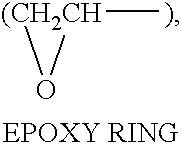Metal oxide-containing film-forming composition, metal oxide-containing film-formed substrate, and patterning process
a metal oxide-containing film and composition technology, applied in the direction of photosensitive materials, instruments, photomechanical equipment, etc., can solve the problems of deteriorating resolution performance of photoresist film, pattern collapse, and inability to accurately transfer resist pattern onto processing substrate, etc., to achieve excellent dry etching characteristic and excellent storage stability
- Summary
- Abstract
- Description
- Claims
- Application Information
AI Technical Summary
Benefits of technology
Problems solved by technology
Method used
Image
Examples
synthesis example 1
[0380]Added into a mixture of 40 g of propylene glycol methyl ether, 1 g of methanesulfonic acid, and 50 g of deionized water, was a mixture of 10 g of phenyltrimethoxysilane, 20 g of 2-(3,4-epoxycyclohexyl)ethyltrimethoxysilane, 10 g of tetrabutoxy germanium, and 35 g of propylene glycol methyl ether; the resultant mixture was kept as it was for 12 hours at 40° C. to thereby subject it to hydrolytic condensation; and then by-product alcohols were distilledly removed therefrom under reduced pressure. Added to the resultant mixture were 800 ml of ethyl acetate and 300 ml of propylene glycol methyl ether, and a water layer was separated from the resultant mixture. Added to the remaining organic layer was 100 ml of ion exchange water, followed by stirring, still standing, and separation. This was repeated three times. Added to the remaining organic layer was 200 ml of propylene glycol methyl ether, followed by concentration thereof under reduced pressure, thereby obtaining 100 g of a p...
synthesis example 2
[0381]Added into a mixture of 40 g of propylene glycol methyl ether, 1 g of methanesulfonic acid, and 50 g of deionized water, was a mixture of 10 g of phenyltrimethoxysilane, 20 g of 2-(3,4-epoxycyclohexyl)ethyltrimethoxysilane, 10 g of tetrabutoxy titanium, 20 g of 2,4-pentanedione, and 35 g of propylene glycol methyl ether; the resultant mixture was kept as it was for 12 hours at 30° C. to thereby subject it to hydrolytic condensation; and then by-product alcohols were distilledly removed therefrom under reduced pressure. Added to the remaining solution was 200 ml of propylene glycol methyl ether, followed by concentration thereof under reduced pressure, thereby obtaining 120 g of a propylene glycol methyl ether solution (polymer concentration of 20%) of a metal oxide-containing compound 2. The polymer was measured for a molecular weight, and determined to have Mw=8,000 relative to polystyrene standards.
synthesis example 3
[0382]Added into a mixture of 40 g of propylene glycol ethyl ether, 1 g of hydrochloric acid, and 50 g of deionized water, was a mixture of 10 g of phenyltrimethoxysilane, 20 g of 2-(3,4-epoxycyclohexyl)ethyltrimethoxysilane, 10 g of tetrapropoxy hafnium, and 35 g of propylene glycol ethyl ether; the resultant mixture was kept as it was for 12 hours at 10° C. to thereby subject it to hydrolytic condensation; and then by-product alcohols were distilledly removed therefrom under reduced pressure. Added to the remaining solution was 200 ml of propylene glycol ethyl ether, followed by concentration thereof under reduced pressure, thereby obtaining 100 g of a propylene glycol ethyl ether solution (polymer concentration of 20%) of a metal oxide-containing compound 3. The polymer was measured for a molecular weight, and determined to have Mw=5,000 relative to polystyrene standards.
PUM
| Property | Measurement | Unit |
|---|---|---|
| wavelength | aaaaa | aaaaa |
| temperature | aaaaa | aaaaa |
| hydrolyzable | aaaaa | aaaaa |
Abstract
Description
Claims
Application Information
 Login to View More
Login to View More - R&D
- Intellectual Property
- Life Sciences
- Materials
- Tech Scout
- Unparalleled Data Quality
- Higher Quality Content
- 60% Fewer Hallucinations
Browse by: Latest US Patents, China's latest patents, Technical Efficacy Thesaurus, Application Domain, Technology Topic, Popular Technical Reports.
© 2025 PatSnap. All rights reserved.Legal|Privacy policy|Modern Slavery Act Transparency Statement|Sitemap|About US| Contact US: help@patsnap.com



